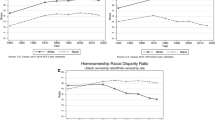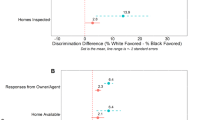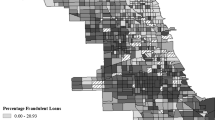Abstract
This paper analyzes patterns in subprime residential mortgage lending using 2006 Home Mortgage Act Disclosure data for the cities of Bridgeport, New Haven and Waterbury, Connecticut. The analysis applies models presented in earlier research and has the objective of assessing the relative importance of demographic versus risk factors in subprime mortgage lending decisions. Regression equations are estimated for census tracts and individual borrowers and include demographic variables and property risk measures. The results find race and ethnicity to be significant determinants of subprime lending in the borrower equations that include the full set of risk measures. Neighborhood educational levels are found to have an inverse and often significant association with subprime mortgage loans. Property risk measures present mixed results regarding their significance in subprime lending, suggesting that risk may have played less of a role in loan originations in 2006 than it did in earlier studies.
Similar content being viewed by others
Notes
Pitkin, et.al. Sub-Prime Mortgage Task Force Final Report. Based on Loan Performance Data. The percent of all loans that are subprime in CT is 12.7, which is below the national average of 14%. Almost 30% of CT subprime mortgages were due to reset between 2007 and 2009.
Using 2000 Census data with 2006 HMDA data raises the possibility of introducing measurement error into the variables if the relative values of the variables among census tracts are affected. A brief comparison was made using American Community Survey data from 2000 to 2006, and did not suggest significant changes in the average values of relevant measures the city level. Differences in the values among Census tracts was not able to be determined.
HMDA data now contain a field for high cost loans which some argue is a better indicator of subprime loans; however HUD notes several reasons why loan price should not replace its list for identifying subprime lenders. See www.huduser.org/datasets/manu.html
Calem et al. (2004a, b) used data on credit scores obtained from CRAWiz; CRAWiz no longer makes this data available. Experian, the original source of the data, makes it available by zip code, not census tract, so this measure of borrower credit risk was not included in the models. This omission is a significant weakness in the models.
The t-statistic is calculated as (bootstrapped coefficient-original OLS coefficient)/standard error of the bootstrapped coefficient in the bootstrapped regression. The distribution of the t-statistic is then used in conjunction with the t-ratio for the coefficient in the original OLS regression to calculate the p-value as the percentage of the t-ratios that are greater than the absolute value of the t-ratio in the original OLS model (Fox 2008, 597-601). White heteroskedasticity-consistent standard errors were also estimated for these equations with similar results.
Neter et al. (1990) suggest VIFs over 10 indicate the presence of mullticollinarity. MEDINC and PCTOWNOCC in Waterbury, and MEDINC in Bridgeport had VIFs over 10. Removing these variables from the Bridgeport models did not change the results. Removing them from the Waterbury models resulted in marginal significance for TURN and NONSUBDENIAL and significance for MEDHSAGE in the purchase model only.
The marginal effects in the tract models give the percentage change in subprime loans in the tract associated with a 1% change in the independent variable. Marginal effects for variables in the loan-level logistic models are computed by raising e to the power of the logistic coefficient (Bowerman and O'Connell 2007) and give the change in the odds that a mortgage will be subprime associated with a one-unit change in the independent variable. A marginal effect of 1.002 for a coefficient with a positive sign is a.2% increase in the odds of a subprime loan for each 1 unit change in the independent variable. Negative coefficients lead to marginal effects less than one; a marginal effect of .95 means the odds of a subprime loan become 95% of the previous value with each 1-unit change in the independent variable.
References
Apgar, W., Calder, A., & Fauth, G. (2004). Credit, capital and communities: The implications of the changing mortgage banking industry for community based organizations. Joint Center for Housing Studies, Cambridge, MA: Harvard University. http://www.jchs.harvard.edu/publications/communitydevelopment/ccc04-1.pdf. Accessed December 14, 2008.
Bowerman, B. L., & O’Connell, R. T. (2007). Business statistics in practice. New York: McGraw Hill.
Calem, P. S., Gillen, K., & Wachter, S. (2004). The neighborhood distribution of subprime mortgage lending. Journal of Real Estate Finance and Economics, 29(4), 393–410.
Calem, P. S., Hershaff, J. E., & Wachter, S. (2004). Neighborhood patterns of subprime lending: Evidence from disparate cities. University of Pennsylvania Law School Institute for Law and Economics. Research Paper No. 04–14. http://www.whartonrealestate.org/newsletter/pdf/may05.pdf. Accessed December 14, 2008.
Canner, G. B., Passmore, W., & Laderman, E. (1999). The role of specialized lenders in extending mortgages to lower-income and minority homebuyers. The Federal Reserve Bulletin (November): 710–723. http://www.federalreserve.gov/pubs/bulletin/1999/1199lead.pdf. Accessed December 14, 2008.
Flachaire, E. (2005). Bootstrapping heteroskedastic regression models: wild bootstrap versus pairs bootstrap. Computational Statistics and Data Analysis, 49(2), 361–376.
Fox, J. (2008). Applied regression analysis and generalized linear models. Thousand Oaks, CA: Sage Publications.
Immergluck, D. (2000). Stark differences: The explosion of the subprime industry and racial hypersegmentation in home equity lending. Chicago, IL: The Woodstock Institute.
Immergluck, D., & Wiles, M. (1999). Two steps back: The dual mortgage market, predatory lending, and the undoing of community development. Chicago, IL: The Woodstock Institute.
National Community Reinvestment Coalition (2003). The Broken Credit System: Discrimination and Unequal Access to Affordable Loans by Race and Age: Subprime Lending in Ten Large Metropolitan Areas. Washington, D.C.: National Community Reinvestment Coalition. http://www.ncrc.org/images/stories/pdf/research/ncrcdiscrimstudy.pdf. Accessed December 14, 2008.
Neter, J., Wasserman, W., & Kutner, M. H. (1990). Applied linear regression models. New York: Richard D. Irwin.
Pennington-Cross, A., Yezer, A., & Nichols, J. (2000). Credit risk and mortgage lending: who uses subprime and why? Research Institute for Housing America, Working Paper No. 00–003. http://www.housingamerica.org/publications/CreditRiskandMortgageLendingWhoUsesSubprimeandWhy.htm. Accessed December 14, 2008.
Ross, S. L., Turner, M. A., Godfrey, E., & Smith, R. R. (2008). Mortgage lending in Chicago and Los Angeles: a paired testing study of the pre-application process. Journal of Urban Economics, 63(3), 902–919.
Scheessele, R. M. (2002). Black and white disparities in subprime mortgage refinance lending. Housing Finance Working Paper Series, HF-014, U.S. Department of Housing and Urban Development. http://www.huduser.org/publications/hsgfin/workpaper14.html. Accessed December 14, 2008.
U.S. Department of Housing and Urban Development (2000). Unequal Burden: Income & Racial Disparities in Subprime Lending America. http://www.huduser.org/publications/fairhsg/unequal.html. Accessed December 14, 2008.
Acknowledgments
The author is grateful to the anonymous reviewer for extensive and insightful suggestions for improving this paper. Gratitude also goes to Stephen L. Ross for providing the wild bootstrap program and to Kam C. Chan for his invaluable assistance and expertise in running the bootstrap models.
Author information
Authors and Affiliations
Corresponding author
Rights and permissions
About this article
Cite this article
DeLoughy, S.T. Risk versus Demographics in Subprime Mortgage Lending: Evidence from Three Connecticut Cities. J Real Estate Finan Econ 45, 569–587 (2012). https://doi.org/10.1007/s11146-010-9281-0
Published:
Issue Date:
DOI: https://doi.org/10.1007/s11146-010-9281-0




